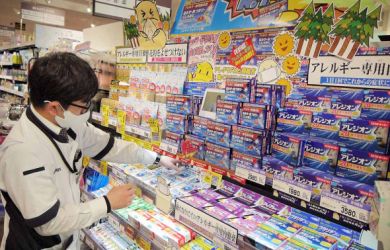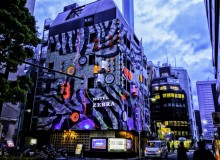
November 17, 2023
Fake Food, Real Art
The century-old history of sanpuru’s artful craftsmanship
By Taylor Bond
Glistening noodles wrapped taut around the wooden edge of a chopstick. Soft, fluffy bowls of rice peppered with bright bits of chopped vegetables, crafting the illusion of steam rising right off the plate. Intricate displays of egg-shell blue syrup drizzled atop dollops of cream, topped with a cherry as the crowning jewel. Decadent. Mouthwatering. And nothing more than plastic.

Sanpuru, or shokuhin sanpuru, are tantalizing, life-like food replicas that blur the line between art and utility. These masterpieces can be seen exhibited outside restaurants, debuting in feature films or television sets, and setting the scene in showrooms and galleries. At first glance, these crafted products might appear to be nothing more than a refreshing form of advertising, but a second look shows the elite level of skill required to construct every minuscule granule of rice, strand of saucy pasta, or soft swirl of garnish adorning the plate. It takes the expertise of a master to transform these pieces from mere chunks of resin into a meal almost worthy of devouring. And though it might be tempting to try and take a bite, it’s not recommended.
While modern manufacturing technology and advancements in material quality have created the ability to produce fake food on a mass scale, the overwhelming majority of sanpuru products in Japan still rely on the highly-trained hand of craftsmanship to imbue each piece with a vitality convincing enough to rival real life. After all, artists have to manipulate wax into a range of shapes, airbrush layers of color, and hand dot every tiny detail onto the replica. It’s a mixture of sculpture and painting with maximum culinary appeal.

Sanpuru’s history officially begins in the late 1920s, when Japanese artisans and candle makers developed replica food items so that restaurant patrons could order with ease, without requiring the use of a menu. However, the tradition of displaying a plate of food outside restaurants in order to entice customers inside extends back even earlier, all the way to the 1800s. Japanese food culture boomed during the Edo period, with vendors and street hawkers peddling food to busy merchants and laborers in the city as more and more people began to eat meals outside of the home. Then, as time passed and the range of options on the menu increased, the real-life displays were swapped with their replica counterparts.
One of the most prolific neighborhoods for experiencing sanpuru goods—and even purchasing a product of your own—is Kappabashi-dori. Tokyo’s kitchenware mecca, Kappabashi is world-renowned for store after store featuring industrial kitchen supplies, high-end Japanese cooking knives, and pottery coming in every shade and shape possible. Here, visitors can browse through sanpuru at their leisure. An aesthetic as functional as it is appealing, sanpuru goods extend beyond mere restaurant replications, and can include key chains, smartphone stands, tie clips, wall clocks, and even back-scratchers adorned with slices of corn or single bites of peeled oranges. These unconventional art pieces can be easily used—and enjoyed—in everyday life. After all, what better way to wake up in the morning than to the buzzing of a takoyaki alarm clock?

Of course, crafting sanpuru isn’t an art form reserved solely for the professionals. An assortment of workshop experiences are offered throughout Japan—with a number featured in Tokyo—for interested amateurs to try their hand at making their own masterpieces. In these workshops, guests are guided by an expert in building a sanpuru item of their very own. Once the experience is finished, the art is packaged and prepared to be taken home, where customers can showcase them throughout their own homes, like every bit of the art they are.
A product with a rich history in Japan, sanpuru goods challenge the conceptions of what “art” should be. These products delight with their whimsy, serve a practical application, and require the hand of a skilled professional to be constructed —combining painstaking precision with abundant creativity. While not hidden away behind frames (unless of course, you count the glass display cases in front of restaurants), sanpuru is no doubt a captivating art form that is guaranteed to charm the senses. So, next time you’re wandering the streets in search of something satisfying to eat, take a second to admire the replica art displayed prominently at the entrance of kissaten, sushi joints, burger grills, pizza parlors, and every cuisine in between.
SANPURU EXPERIENCE
¥9,000
byfood.com







